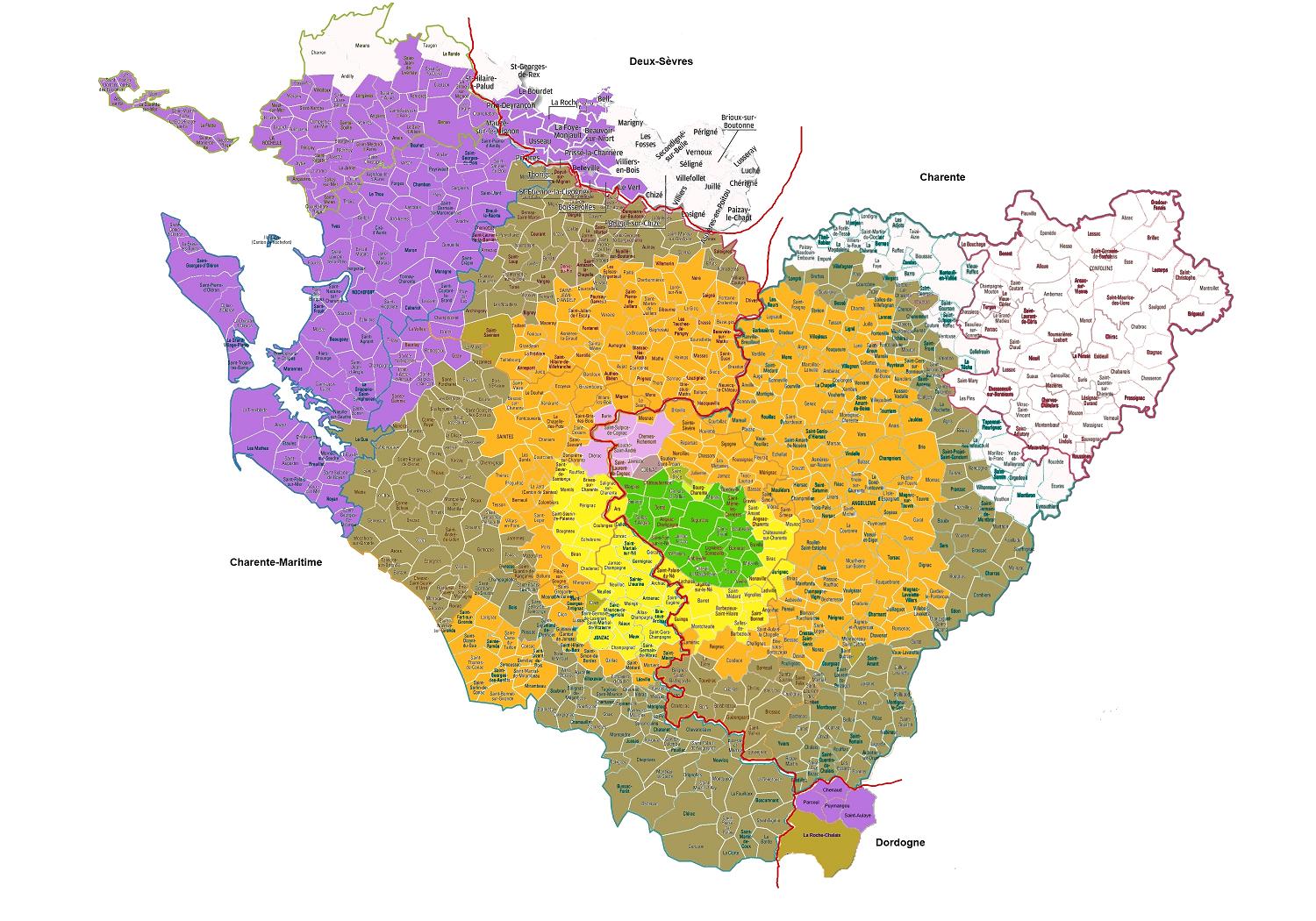The Cru’s and their communities
The cognac area is situated in the Charente region, but this delimitation is not very precise. The Charente region owes its name to the river Charente flowing through it and there actually are two departments named after this river: Charente and Charente-Maritime. Charente-Maritime is bordering the coast and Charente is situated East of Charente-Maritime. For the most part these two departments make up the cognac region, but there are a few exceptions: two small parts do not belong to the cognac region and two parts of other departments do.
(For more details: on the bottom of the page are some links to sub-areas.)
As can be clearly seen on the above map five communities in the Nort-west part of Charente-Maritime and an even lager number in the North of Charente are not part of the cognac region. They are in white.
And then there are two small areas in two other departments that have an appellation controlée de Cognac: one in the South of Deux-Sèvres – North of Charente-Maritime – and one in the South which is part of the Dordogne department.
Other particularities:
Grande champagne
- Grande champagne is in its entirety situated in the Charente department.
- The city of Cognac partly belongs to the Grande champagne area and partly – the part North of the river Charente – to the Borderies area (on the map: two different shades of green).
- Two other Grande Champagne communes – Bourg-Charente and Saint-Brice – also are not entirely Grande Champagne. The part of Bourg-Charente North of the Charente river is Petite Champagne and the part of Saint-Brice North of the Charente river is part of the Fins Bois area (on the map they have different colours). So a tiny little piece of Petite Champagne is situated just above the Charente river, above Grande Champagne territory even.
Petite Champagne
- The Petite Champagne territory is spread out in the two departments Charente and Charente-Maritime.
- Two communes are not fully Petite Champagne: Bourg-Charente (the part South of the river Charente is Grande Champagne area) and Clam which is partly Fins bois (the part South-west of the D142). On the map they have different colours.
Borderies
- Borderies too is spread over both Charente departements: two communes in Charente-Maritime and six in Charente, one being the commune Cognac which is partly Grande Champagne territory (South of the river; different colour on the map).
Fins Bois
- There are three Fins Bois areas that are separated from each other: one is situated in a circle around the Grande Champagne, Petite Champagne and Borderies areas; the second is bordering the Gironde river; and the third is just a small enclave and comprises one commune, Vaux-Lavalette, in the East of Charente (the little smudge on the map)
- Almost all off Fins Bois is surrounded by Bons Bois territory. On three places the Fins Bois breaks through the Bons Bois circle to touch the outer border of the cognac region: in the North the three communes Chives, Les Gours and Saint-Fraigne; in the East Vaux-Lavalette and in the South-west the Gironde area.
- Finally there are also three communes that are not fully Fins Bois: Sainte-Brice: the part South of the Charente river is Grande Champagne; Saint-Savinien: the part that in the past was called Coulonge-sur-Charente belongs to the Fins Bois, the western part is Bons Bois; Montmoreau-Saint-Cybard: the part that used to be the commune Saint-Cybard belongs to the Fins Bois, the other part Bons Bois (different colours on the map).
Bons Bois
- Bons Bois territory is to be found in three different departements: Charente, Charente-Maritime and Dordogne.
- In Dordogne part of the commune La Roche-Chalais – the part that was La Roche-Chalais in 1938 – belongs to Bons Bois. The eastern part of the commune is Bois Ordinaires (different colour on the map).
- Other communes that are partly Bons Bois are Montmoreau-Saint-Cybard (northern part is Fins Bois) and Saint-Savinien (eastern part is Fins Bois).
Bois Ordinaires
- The Bois Ordinaires cru does not have a right to the appelation d’origine of the cru (they are allowed to be called Cognac, but not to be called Bois Ordinaires) and they too are spread out over three different departements: the vast part is in Charente-Maritime. Both other parts are in Deux-Sèvres and Dordogne.
- The Dordogne department has one commune only that is partly belonging to Bons Bois: La-Roche-Chalais.
- Charente-Maritime has three isles, all three are Bois Ordinaires territories: Ile de Ré, Ile d’Oléron and Ile d’Aix.
- Strictly speaking a fourth isle exists, belonging to the Bois Ordinaires area: Ile Madame. This isle is connected with the mainland with a cow path that only can be used when low tide. No vineyard exists on ths isle however.
For those who feel the need to be able to read the names of the communes I pepared maps of sub-areas:
- Western part and isles
- Upper left part
- Northern Fins Bois
- Central part with Grande Champagne, Petite Champage and Borderies
- Southern part
- Eastern part


Comments
Communities per cru — No Comments
HTML tags allowed in your comment: <a href="" title=""> <abbr title=""> <acronym title=""> <b> <blockquote cite=""> <cite> <code> <del datetime=""> <em> <i> <q cite=""> <s> <strike> <strong>